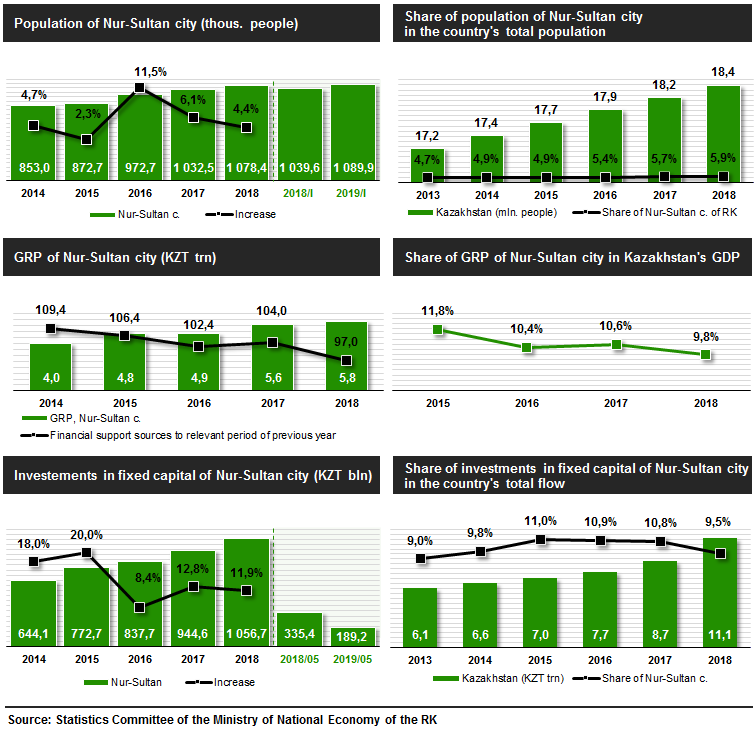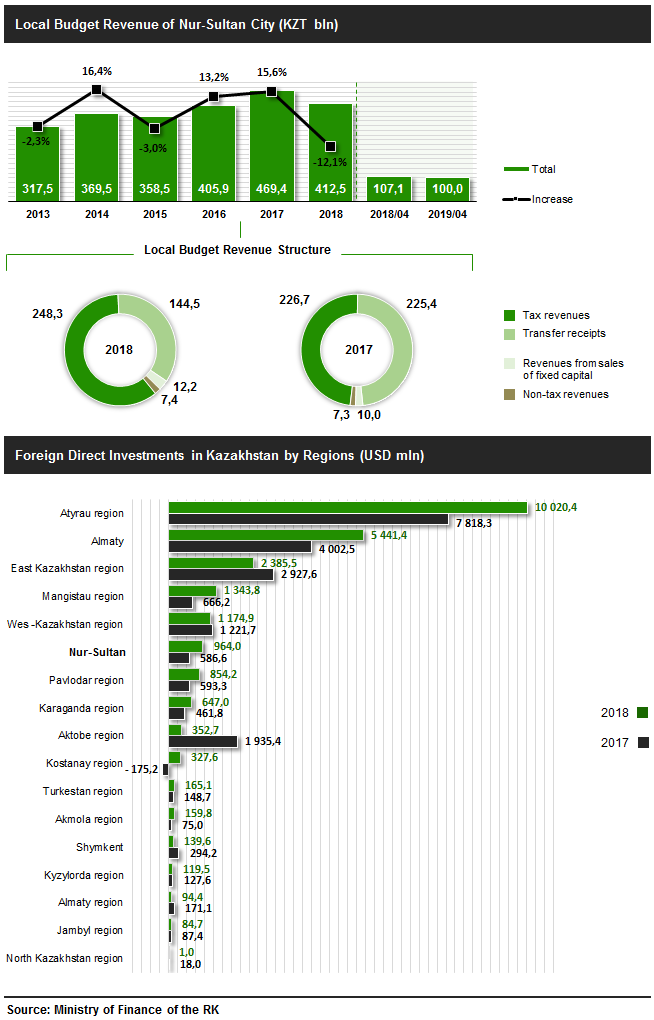On July 6, Kazakhstan will celebrate the Day of the Capital City: we have prepared the financial and economic overview about the development of Nur-Sultan city as a «smart capital», financial center and regional investment hub. At the end of 2018, 9.8% of gross domestic product was produced in the capital, 8.7% of public revenue was generated and 9.5% of funds were raised for the country’s fixed capital.
Nur-Sultan city plays a special role in the modern development of the national economy. The area of the city is 801.5 sq. km, 5.9% of the population of the country lives here (as of the end of Q1 2019 – 1.1 m people). The city’s gross regional product for 2018 reached KZT 5.8 t., it constituted to 3,7% in monetary terms over the year. At the end of 2018, GRP per capita made up USD 16 K (KZT 5.5 m), while the mean value across the country is USD 9.5 K (KZT 3.3 m).
Since 2014 industrial output increased by more than twice — from KZT 146.8 B to KZT 340 B. In percentage terms, the share of industry in the city’s GRP for the similar period went up from 3.7% to 5.8%. Industries that account for majority of GRP (41.1%) are wholesale and retail trade; repair of vehicles and motorcycles (KZT 1.1 T); professional, scientific and technical activities (KZT 672.5 B) and real estate transactions (KZT 637.5 B).
Along with this, the local executive authorities carry out the work on implementation of innovative projects and attraction of investors to the special economic zone (SEZ), which already helped to launch 393 projects among 153 participants of the SEZ to the amount of about KZT 2 T. Thus, 71 projects are implemented in Industrial Park # 1, for which KZT 143.2 B were raised, and products to the amount of more than KZT 1.1 B were produced.
Today, Nur-Sultan city is an international hub, which concentrates investment flows. The amount of capital investments into the city’s economy made up KZT 1.1 B — by 11.9% more than the year before, and by twice as much compared with 2013. Over the five months of 2019, investments in the city’s fixed capital made up KZT 189.2 B.

Over the last three years, the capital’s economy was financed to the amount of KZT 1.3 T, of which KZT 560.1 B — has come out of transfer. At the same time, there is a notable increase in tax revenues in the budget income structure over the last years: from 47.6% in 2015 to 60.2% in 2018. Growth in own income was accompanied by planned decline in transfer receipts for the same period: from 63.6% to 35%.
The city’s favorable economic environment promotes the growth of own income in the total revenue structure, which helps to gradually reduce the share of state participation in generation of local government revenue. According to approved budget of Nur-Sultan city for 2019–2021, revenues should make up KZT 437 B (+5.9% by 2018); of which tax revenue — KZT 264.2 B (60.4%), transfers — KZT 161.6 B (37%).
The capital city also attracts the attention of foreign investors. For the last year, USD 964 M were attracted from foreign investors for the implementation of projects and for the development of the city’s infrastructure as a whole — by 64.3% more than the year earlier (USD 586.6 M).
In addition to the city’s infrastructural development, strong emphasis is given to the implementation of Smart Astana project, the basis of which is formed by the best world’s practices and 6 main characteristics of “Smart City”: smart economy, management, life, mobility, people and environment. In this area, the work on implementation of “Safe City” project, Smart City is carried out jointly with involved foreign consultants. In the pilot mode, such projects as “Smart Street Lighting”, “Smart School” and “Smart Polyclinic” were launched. All the above listed projects are aimed at ensuring the safety of the city’s residents, raising the level of provided services, cost optimization and creation of favorable living environment.
The new paradigm for the development of world cities is creativity that becomes the most important factor that affects the manufacture of products in economically developed countries. This phenomenon offers opportunities for the implementation of non-standard projects and generation of capital.

In the capital city, the migration flows are still high: 114.4 K people moved in Nur-Sultan city in 2018, and 91.6 K people moved out. Thus, the migration balance was 22.7 K people. As of the end of Q1 2019, the migration balance is 5.9 K people.
Nur-Sultan, being the young capital city, which development is focused towards the implementation of new technologies and creation of base for expanding the use of human capital, possesses a number of advantages over the world’s large cities according to such criteria as internal stability, population growth and life expectancy, mobility of human factor as well as flexibility in expansion of promising production.
In addition, the capital city is one the country’s main expat centers, as well as the location for the development of external and internal tourism. One of the effective resources for attraction of inbound tourism is the development of Nur-Sultan as an international cultural center. Over the last year, passenger carriage by air amounted to 7.9 B people, 4.5 M of which were provided by the capital city’s airport — this is the highest index for the entire history of air services.
Within the development concept of Nur-Sultan city until 2050, 7 core systemic directions are identified:
- business services (logistics above all, financial sectors, small business);
- development of high-tech industry in the sectors of railway and air machine building, instrument engineering, refining (and energy-saving technologies in the longer run);
- adoption of “green economy” principles and development of the city as Smart City;
- medical services, pharmaceutics;
- educational services (science city founded on the basis of “Nazarbayev University” JSC);
- tourism industry;
- trade.
In March 2018, the capital of Kazakhstan was, for the first time, included in the list of the global financial centers (The Global Financial Centres Index), taking 88th place. In the next updated September rating of the same year, Nur-Sultan city was ranked 61st. In 2019, Nur-Sultan moved up by another 10 lines (51th place) and became a leader among the financial centers of Eastern Europe and Central Asia, surpassing such megapolises as Istanbul, Saint Petersburg, Moscow and Almaty. By 2050, Nur-Sultan is expected to join the world’s top 10 cities.

